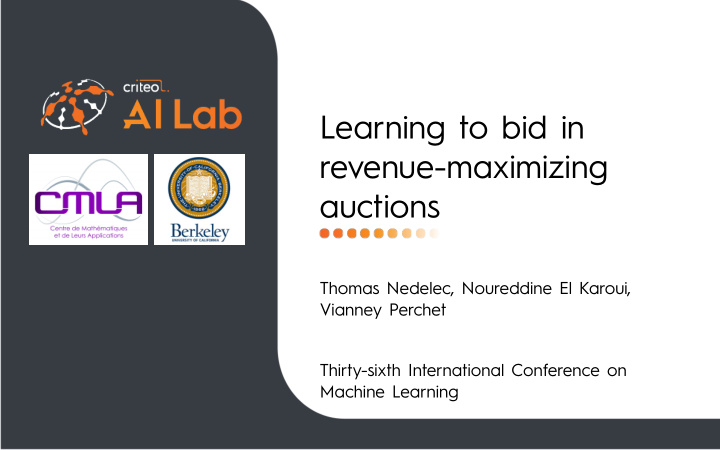



Learning to bid in revenue-maximizing auctions Thomas Nedelec, Noureddine El Karoui, Vianney Perchet Thirty-sixth International Conference on Machine Learning
Some historical reminders Roger Myerson second price, T-auctions, deep auction: eager/lazy, boosted approximations of the Myerson based on the virtual value. Several For assymetric bidders, allocation learning for auctions... PDF) of the value distribution of if we denote by F the CDF (f the revenue-maximizing auction. well-defined reserve price is a second-price auction with if bidders are symmetric, Revenue-maximizing auction one bidder, the monopoly price r ∗ satisfies: r ∗ = 1 − F ( r ∗ ) f ( r ∗ ) .
What is happening in practice : the online advertising use case 1. key assumption of Myerson : the auctioneer knows the value distribution F of the bidders : F is common knowledge. 2. in practice, this is not true...! 3. however, the auctioneer receives every day billions of bids of the different bidders : if the bidders bid truthfully, the auctioneer can learn F assuming bids are IID examples of the valuations of the bidders.
An example on Criteo Data Figure: This plot was done on Criteo data. We bucketize all the requests we receive by the reserve price that was sent by a large ad platform. We then look on each bucket what would have been the optimal reserve price for Criteo. The plot is in log scale.
Key questions: the bidder's point of view Is it still dominant to bid truthfully when the seller is learning the reserve price from past bids ? What are the best bidding strategies when auctioneers are learning on past examples of bids to set the correct reserve price ?
A variational approach Lemma virtual value associated to the new distribution of bid) is given by: The utility of the strategic bidder using the strategy β increasing ( ψ B denotes the ( ) Bidder Utility ( r ) = E X i ∼ F i ( X i − h β ( X i ))) G ( β ( X i )) 1 [ X i ≥ x β ] . with h β ( X ) = ψ B ( β ( X )) = β ( X ) − β ′ ( X ) 1 − F ( X ) and x β the reserve value. f ( X )
Experiments (exponential distribution) +113% Auction Type Uplift vs truthful bidding +73% +37% +19% Myerson auction Utility of strategic bidder Uplift vs truthful bidding +87% Eager second-price +67% Boosted second-price Utility of strategic bidder Uplift vs truthful bidding +60% +71% +52% Learning to bid in revenue-maximizing auctions ICML'19 Utility of strategic bidder 7 / 8 +14% 0.25 K=2 K=3 K=4 Baselines truthful revenue maximizing 0.30 0.24 0.21 truthful welfare maximizing 0.50 +29% 0.33 +50% Lazy second-price Utility of strategic bidder Uplift vs truthful bidding 0 . 45 ± 0 . 001 0 . 31 ± 0 . 001 0 . 24 ± 0 . 001 0 . 52 ± 0 . 02 0 . 33 ± 0 . 02 0 . 25 ± 0 . 02 0 . 64 ± 0 . 001 0 . 45 ± 0 . 001 0 . 35 ± 0 . 001 0 . 48 ± 0 . 03 0 . 41 ± 0 . 001 0 . 32 ± 0 . 001 Table: All bidders have an exponential value distribution with parameter λ = 1 .
Recommend
More recommend